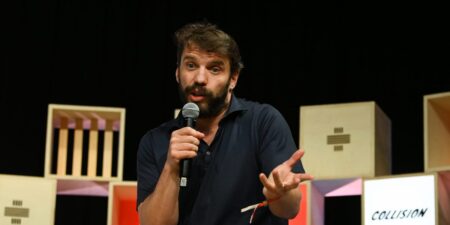Russia’s kill chain, or how quickly the army moves from finding a target to firing on it, is now far more responsive and precise than it was at the start of the war in Ukraine.
Federico Borsari, a resident fellow researching war technology and innovation at the Center for European Policy Analysis, told Business Insider that “the Russians are adapting, and this is definitely something that NATO is noticing.”
Russia is outpacing the West in artillery production, raising the prospect that NATO must deter an adversary with more battlefield firepower and the fleets of reconnaissance drones that guide it.
Russia’s rough start to the war
One of the more serious problems for Russia early in the conflict was that the time between finding a target and firing on it was far too slow. It took hours for indirect fires like artillery and mortars, and even longer for cruise missiles.
Borsari wrote in a report published in early April that Russian strikes were sometimes delayed by up to four hours, making them ineffective against Ukrainian units that had long since moved on to a new position.
“In the case of the tactical ballistic missile, this was very much the case,” he told BI. “Sometimes, it took even longer.”
Researchers at the London-based Royal United Services Institute think tank wrote in November 2022 that Russian forces “have missed targets because of self-imposed frictions in their kill chains, usually striking too late rather than not at all.”
A challenge is that Russia’s reconnaissance strike complex was ineffective, dependent on aging satellites and a smattering of drones that couldn’t keep up with the pace of the fighting.
Russia used surveillance drones like the Orlan-10 and Forpost early in its invasion, as evidenced by Oryx’s open-source records showing several were destroyed in the spring of 2022. But there were too few of these intelligence, surveillance, and reconnaissance (ISR) assets to be effective.
Target selection suffered. Sometimes, the invading Russians would waste tactical missiles on small groups of Ukrainian infantry while peppering vast airfields with a handful of cruise missiles.
Another issue was that Russia’s early command and control systems were too rigid, outdated, and confused, carrying the top-down hallmarks of the Soviet command structure. After collecting timely intelligence, troops on the ground had to wait for strikes to get approved through different rungs of command.
And confusion only slowed that down. Many Russian soldiers and officers were also often unclear on their responsibility areas, problems that were exacerbated by communication and tech issues.
For example, in the early war, many Russian units didn’t have the Strelets laptops that allowed them to target Ukrainian forces effectively, RUSI researchers wrote in May 2023. The software consolidates intelligence data from drones and recon units, displaying it on a live map for commanders.
Yet Russian units that did have the computers, the researchers wrote, often left them sitting in baggage or didn’t know how to set them up.
How Russia fixed its kill chain
Now, Russia uses a wide range of tactical drones to acquire targets in Ukraine, flooding the airspace with hundreds of observer systems at different altitudes and depths. Sometimes, these ISR platforms can work together to feed Russian commanders different visual angles of the same target.
As the Kremlin started to surge drone production, what was a scarce resource in the early invasion soon became the backbone of Russia’s reconnaissance. In 2023, Moscow’s state media outlet TASS reported that Russia had increased its supply of the Orlan drone by more than 50 times.
Insufficient Ukrainian air defenses have also given Russia more freedom of maneuverability with its bigger recon drones, allowing it to collect intelligence on Ukrainian operations in the rear and conduct effective strikes reminiscent of the HIMARS strikes that proved tremendously effective against the Russians.
With the drones providing Russia a better view of the battlespace, it’s been increasingly using short-range ballistic missiles like the Iskander-M and its devastating glide bombs to hit high-value targets in the Ukrainian rear more precisely.
A temporary dearth in artillery ammunition in 2023 also meant Russia had to learn to switch from mass bombardments — a bread-and-butter tactic — to precision strikes.
Additionally, Russia’s command structure has evolved since the early days of the war.
RUSI land warfare researchers Jack Watling and Nick Reynolds wrote in a 2023 report on Russian battlefield tactics that “Russian artillery has begun to significantly refine the Reconnaissance Strike Complex” after watching the Ukrainians devastate their ammunition stores and their command and control centers with HIMARS strikes.
“This has resulted in much closer integration of multiple UAVs directly supporting commanders authorised to apply fires,” they said, noting that “Russian artillery has also improved its ability to fire from multiple positions and to fire and move.”
And Russia began better employing the Strelets system for greater coherence in combat.
Other technology has also played a part. Like Ukraine, Russian troops have been integrating civilian tech into their operations, such as smartphones and satellite communications terminals. That approach has made Russian units at the lower level more cohesive and able to merge intelligence and strike command in a single picture.
In October, for example, Russian troops were widely seen using the video gaming messaging app Discord to relay real-time information about the battlefield and coordinate strikes.
While these systems are easier to use, there are notable drawbacks. For instance, smartphone use on the battlefield has resulted in strikes on the user’s position, intel leaks, and other problems. Military leaders, from Russia to the US, caution against this behavior.
NATO needs to pay attention
Russia’s faster, improved kill chain means that Western forces bracing for the possibility of a great-power conflict should focus even more on training troops to fight while moving quickly and in small formations to reduce exposure to strikes, Borsari said.
“Since the full-scale invasion started, there has been an incredibly higher emphasis on the need for more dispersed and disaggregate forces on the part of NATO,” he said.
Disaggregation has been increasingly recognized as a necessity on the modern battlefield. It’s a driving factor behind Western training activities like highway operations for combat aircraft, but there’s more work to be done.
Sam Cranny-Evans, the director of the UK consultancy Calibre Defence, wrote in January for the Centre for Historical Analysis and Conflict Research that NATO should expect a more experienced Russia ready to fight with precision.
“This is important for the British Army and its allies,” he wrote, “as the available evidence indicates that Russia has moved away from the Soviet roots that informed its counter-battery doctrine, toward one that is precise, lethal, and operable at scale.”
Borsari said a more immediate action the US and Europe can take is targeting Russia’s manufacturing for high-tech drones and precision munitions, which often rely on parts from overseas.
“Western sanctions have, in a way, slowed down the procurement of components for that production. That would affect Russia’s ability to deploy at scale and sustainably,” he said.
Read the full article here
















